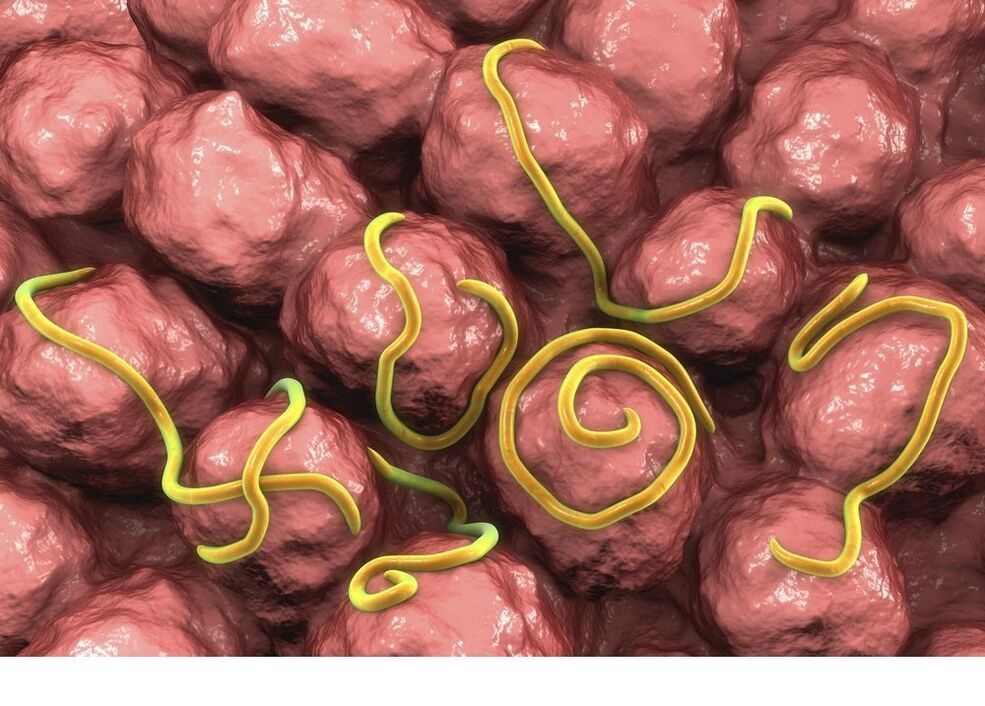Helminthiases, or diseases caused by helminths, are among the most common in humans. According to rough estimates of experts from the World Health Organization, every fourth person on the planet is infected with one or one helminth. And that’s not surprising, because you can catch this infection almost anywhere in the world. Doctors equate the incidence of helminthiasis with the spread of influenza and ARVI.
Doctors estimate the scale of worm infections in our country is 270 cases per 100 thousand population, but the actual incidence, according to experts, several times higher. This is due to the fact that a person is often unaware that an uninvited guest has settled on his or her body. If helminths do not manifest themselves in any way, the disease may go undiagnosed for decades.
It's all about helminths
Parasitic worms, helminths or worms?
This vast group of living beings has several names at once. First of all, we are talking about parasites, which are living organisms that live at the expense of others. In addition, we are talking about endoparasites, which are living in other organisms - in their tissues and organs. Finally, we are talking about worm -like creatures, which are suitable to live long in the bodies of infected animals and reproduce effectively.
Therefore, helminths are parasitic worms. The term "helminths" was once introduced by Hippocrates. Among the people, these unpleasant creatures are also called worms - from the ancient Greek word, simply meaning parasitic worms.
So, talking about helminths, we will not go wrong, call them worms or parasitic worms. And if we talk about helminthiasis, the disease can also be called a "parasitic infection. "
Various helminths in humans

In total, scientists know about 287 types of helminths that can parasitize humans. In our country, only 65 species have been identified, and only 24 species are the most common.
Helminths in humans live all over the body, and each species has its own preferences.
Basically, worms prefer the gastrointestinal tract and especially the small intestine, where you can find ascaris, cream worms, three types of tapeworms, tapeworms, tapeworms, and others. Vlasoglav alone occupies the large intestine.
In the liver, more precisely in the bile ducts, as well as in the gallbladder, flux, opisthorchis, etc. can be found. Incidentally the lungs settle in the lungs. Trichinella affects muscles. Adult pig tapeworms live in the small intestine, and larvae (cysticercus) can be found in the eyes and central nervous system. Schistosomes (helminths from the tropics) prefer the veins of the gastrointestinal tract and genitourinary system.
Filariae are generally found everywhere - they can be found in the lymphatic system and in closed body cavities - in the retroperitoneal space, in the pericardial sac, and their larvae are usually found in the blood or in the skin.
Types of helminths that live in humans
Helminths, the most interesting type for doctors, are divided into two main types: flat and round (nematodes). Classification is made on the basis of the cross section of the body of the worm: on the round worm it is circular in shape, and on the flat worm it is flattened in the direction from the conditional buttock to the conditional stomach. Flatworms are further divided into two classes: worms (trematodes) and tapeworms (cestodes).
- Nematode. A large number of nematodes are inhabitants of the human intestine. This group includes ringworms, cream worms, Trichinella, whip worms, etc. , very different from each other - from a few millimeters to 1. 5 meters. They all have their own well -developed digestive system. Nematodes have both males and females. It is not difficult to distinguish it in adults: females are usually twice as large, and besides, in males, the "tail" is rotated towards the "belly".
- Trematod. The body of the trematode resembles a leaf or lancet in shape and cannot be compared in size with other helminths: it is a small worm, from a few millimeters to 3. 5-5 in length. 5 cm. Unlike ringworms, trematodes have a pair of suckers in the mouth and stomach. Their digestive system is still in its infancy. Most of the species from this group are hermaphrodites, that is, they combine the characteristics of both sexes. The exception is schistosomes, which have both males and females.
- Code. The cestode is a worm, which is a long ribbon broken into short segments, at one end of which there is a head with a hook and a sucker. These worms live exclusively in the small intestine - the whole body does not enter other organs. And this is not surprising, because the length of the tapeworm can reach 10-11 meters. They have absolutely no need for the digestive system, as they absorb everything they need from the food a person eats. All tapeworms are hermaphrodites.
Organisms in which helminths live at the larval level are called intermediate hosts (they can be animals, fish, mollusks and, of course, humans), and adult form carriers are referred to as final hosts.
Depending on whether a given type of worm has a stage of development in the intermediate host body, they also talk about bio- and geohelminthiasis.
- Geohelminths do not have such levels. Worm eggs fall into the ground, where they wait until, by the will of destiny, they are brought into the body of the future owner. Geohelminths include tapeworms, tapeworms, mineworms, etc.
- Biohelminths have such levels, and there may be several hosts. Examples include Trichinella, tapeworms, schistosomes, all flatworms, etc.
Some scientists now, by mechanism of transmission, distinguish a third group of worms - infectious worms, which include cream worms (geohelminths) and dwarf tapeworms (biohelminths). The parasite is spread through contact with infected people.
In addition, depending on which host plays an important role in the life of helminths, anthroponosis and zoonoses are isolated.
- The first category includes helminthiasis, in which a person is a mandatory stage in their life cycle: ascariasis, enterobiasis, etc.
- Zoonoses include helminthiases, the causative agent of which successfully exists without a person, but at the same time our species is also susceptible to it, and if an infection occurs, then the worms will not interfere with life and well -being. This category includes opisthorchiasis, diphyllobothriasis, etc.
How does a helminth infection occur?
Often, people are infected with worms, so to speak, orally, that is, swallowing worm eggs. The most striking example is a cream worm, an egg that can be picked up by a child in a sandbox (a way of spreading household infections) The food path (through food) is characteristic of ringworm-through contaminated vegetables or fruits and trematodes that enterbody while eating contaminated but improperly processed seafood or meat, etc.
However, food is not the only way of helminth infection. Eggs can enter the human body through inhalation of dust. And tapeworms and schistosomes enter the body through the skin - and they are called infectious worms, and the route of infection is percutaneous. And because schistosomas can be picked up while swimming in a pool, this path of infection is also called aquatic.
In the tropics, a living filamentous plant, it is also wuchereria, which spreads with the help of mosquito bites. And this is the vector -carried route of infection.
Infection with helminths can also occur through contact with infected animals - cats and dogs. Usually, people get tapeworms (toxocar, etc. ) and tapeworms from animals. Pets, in the process of licking, carry worm eggs through the fur. A person, after petting such an animal and not washing his hands immediately afterwards, is at risk of injecting the infection into his mouth. Another option for worm attacks is to clean the trash can without gloves.
How do helminths affect the body?

Mechanical effects
This category includes any worm action in which the integrity of the host tissue is violated. For example, adult helminths with hooks and suction cups correct themselves with their help, while damaging the gastrointestinal mucosa. As a result, tissue erosion develops in the area of localization of the worm, boils form, and the nutritional process of the mucous membrane is disrupted, which can even lead to its death (necrosis).
Moving the body, the so -called migratory larvae can also cause bleeding and inflammation in the damaged area - this makes it easier for them to penetrate deep into the tissue. And worms in the intestine often provoke the development of appendicitis, intestinal obstruction and even rupture.
Eventually, the cysticercus, which has entered the brain and is actively growing there, squeezes the tissue, which can lead to a person’s death.
Reduce nutrient deficiencies
First, the helminths themselves "rob" their hosts, eating the food they eat. Second, some human worms feed on their own blood - this is what mine worms and whip worms do, or they take in substances needed for hematopoiesis. Therefore, against the background of parasitic infections, anemia can develop.
With prolonged chronic infection with helminths, which absorb valuable metabolic nutrients, protein-calorie deficiency is diagnosed.
Poisoning the human body with helminth toxins
The metabolic products of whipworms and tapeworms destroy erythrocytes, and the secretion of ascaris causes capillary development and, as a consequence, bleeding.
Some parasitic worms begin to pose an increased danger after death, releasing substances with necrotic and hemotoxic properties.
Allergy to helminth proteins
Helminths are foreign organisms to us, therefore, our body considers many of the proteins secreted by them (in the process of vital activity or after death) as potentially dangerous and may regard them as antigens. During sensitization to this antigen, antibodies are formed - immunoglobulin IgE and IgG -4. These antibodies, when in contact with mast cells, basophils and eosinophils, cause their destruction. At the same time, there is a release of substances that trigger allergic reactions (allergic mediators) - histamine, serotonin, heparin, etc.
Suppression of the body's defenses
The negative effects of helminths on the body can be indirect. Tapeworms, which are located, as mentioned above, in the small intestine, can cause a decrease in gastric acidity. And this significantly reduces protection against the penetration of pathogenic bacteria into the body.
Many helminths have immunosuppressive abilities, that is, they suppress the body's defenses, thus ensuring a comfortable existence for a long time. This is an evolutionary adaptation obtained by them during adaptation to a narrowly defined host loop. But suppression of the human immune system leads to increased susceptibility to infections and other diseases.
Risk of cancer

Some chronic helminthiasis significantly increase the chances of cancer. Parasites during their vital activity destroy tissues and organs and thus provoke the development of malignant tumors in this place. Cancer often develops against the background of opisthorchiasis, schistosomiasis, clonorchiasis, etc.
The travel phase of helminthiasis
What are the signs of helminthiasis? Once the worms enter the body, the symptoms of the infection will depend on the phase of the disease.
During helminthiasis, there are 4 main phases:
- Acute (early) helminthiasis phase. At this stage, the causative agent of the infection enters the human body, causing the body’s sensitivity to helminth proteins. The first symptoms of helminths appear 2-4 weeks after infection. Usually during this period, allergic -like reactions develop - itchy skin rash, conjunctivitis, cough, lymph nodes, inflammatory processes in the joints, analysis shows an increase in the concentration of eosinophils, etc.
- Latent phase. At this stage, the helminth develops into an adult state and is eventually determined with a permanent residence, after which the helminthiasis enters a chronic stage.
- Chronic phase (late). At this stage, adult helminths actively reproduce, producing tens and hundreds of thousands of eggs and larvae, which enter the external environment or spread to other organs of the body. Helminths in children can provoke muscle spasms, seizures - epilepsy, hysteria, etc. Doctors state that all these signs of helminthiasis are not specific and similar to the symptoms of dozens of other diseases, so it is impossible to diagnose it. More precisely, there are some helminths, whose symptoms are very typical, but they should be checked using a number of tests.
- Production phase. The term means the complete recovery of the patient, or his incapacity against the background of helminthiasis complications. These include malignant tumors in opisthorchiasis and schistosomiasis, liver cirrhosis, etc.
Helminths: symptoms of infection

How helminthic invasion (invasion of helminths into the body) will affect the human body is determined by many factors: method of penetration, degree of infection, duration of disease and lifespan of the helminth, characteristics of the nutritional cycle and development.
In general, doctors distinguish the following symptoms of a helminth infection, in case you should see a doctor and undergo an examination:
- periodic nausea and vomiting, abdominal pain;
- frequent allergies;
- sleep disturbances, chronic fatigue, irritability;
- itching in the anal area;
- frequent urinary tract infections;
- chronic gastrointestinal diseases, dysbiosis;
- symptoms of chronic intoxication of the body: frequent colds, blue circles under the eyes, pale, enlarged lymph nodes;
- vulvovaginitis;
- increased levels of eosinophils in blood test results;
- delayed growth and weight gain.
The question arises: if helminths settle in the body, will the symptoms of the infection be visible immediately or only after a while? Are there helminths that are difficult to detect for signs of infection? Doctors point out that with non -intensive invasion, the first symptoms of helminthiasis can appear in one, two months, and after several years. That is, so far, there have been no signs of infection with helminths.
Manifestations of helminth infections in children
Helminths are more common in children than in adults. This is explained by a lack of hygiene skills, as well as close contact with the environment, which can be a source of worm eggs. Such an environment can be a sandbox in a playground, a bed in a grandmother’s dacha, someone else’s toys played by an infected child, etc.
What complaints are most often noted when a child is infected with intestinal nematodes:
- gastrointestinal tract dysfunction - 75% of children;
- allergic reactions - 71%;
- sleep disorders - 54%;
- appetite disorders - 44%;
- pain in the abdomen - 40%;
- itching in the anal area - 36%.
More rarely, against a background of infection with helminths, children suffer from immune disorders (19%) and bruxism, i. e. grinding teeth (16%) This is a paradox, but both of these symptoms are generally considered by the population as signs of worms.
Diagnostics of helminthiasis
What are the tests for helminths?

It should be understood that helminth analysis alone is not sufficient. No method available for detecting parasitic worms by itself can be the basis for making a definite diagnosis. According to doctors, in some cases, positive results can be achieved only for 8-10 times! There may be many reasons for this: females lay eggs at different intervals that do not coincide with the time of sampling, biomaterial samples turn out to be empty, because taken in the wrong place, the disease is in phase so that it is determined by the chosen method is almost impossible, etc. .
The most common types of analysis for helminths are fecal studies for helminth eggs, perianal abrasions, analysis of duodenal contents, analysis of biomaterials from the patient’s lungs, blood tests for helminths, etc.
More rarely, urine is required for diagnosis (schistosomiasis of the genitourinary system, enterobiasis), studies are performed for patients muscle helminths (trichinosis) by sampling of material by biopsy method.
How is feces tested for worm eggs?

For analysis of helminths, 50 g of patient stool is enough (this is about 1 tbsp). Today in the pharmacy you can buy a special clean container for testing, in which you need to collect feces for worm eggs. It is better to give the sample to the laboratory on the same day (for strongyloidosis and ankylostomiasis - no later than 4 hours after collection). If necessary, you can store fecal samples for helminths no more than a day at a temperature of 0 to 4 ° C, it is very impossible to freeze them. In principle, it is possible to use special preservatives that allow samples to be stored for up to several months.
Perianal scraping - analysis for worm eggs
Perianal abrasion is used to diagnose helminthiasis such as enterobiasis, teniasis, teniarinchiasis, and others. Unlike fecal analysis for helminths, scraping material is collected from the skin around the anus using a cotton swab, wooden spatula, glass eye stick or adhesive tape. The material collection procedure for helminth egg analysis was performed in the early morning, and patients should not wash themselves in the afternoon or morning.
Important point: even repeated analysis for helminths in this way does not guarantee the reliability of the results in cases of enterobiasis. Female cream worms lay eggs periodically, and if you don’t catch the "right moment", then you can be sure that there are no eggs - no worms.
Analysis of the contents of the duodenum (bile)
Bile collection was performed using an empty stomach tube. Because this method is invasive (unlike methods such as feces for worm eggs, urine collection and perianal abrasion), this method is only prescribed for strict indications when there is a reasonable suspicion of a particular helminthiasis. Bile was examined for larvae of strongyloides and mine worms, and individual bile portions were also analyzed for the presence of worm eggs living in the pancreas and liver ducts.
Blood tests for helminths

In addition to the above methods, there are also serological methods mentioned for the diagnosis of helminthiasis. In this case, blood tests are performed for helminths, more precisely, for antibodies against them.
The main serological method today is the enzyme -linked immunosorbent assay (ELISA), which is distinguished by high specificity and the highest sensitivity (90%) among all other methods. It means, you can pinpoint the type of helmins a person is infected with, and allow you to detect them, even if there are few of them. The reliability of ELISA is 60%. ELISA is particularly relevant for detecting so -called tissue helminthiasis, in which parasitic worms are present in a patient’s organs and tissues (trichinosis, toxocariasis).
Instrumental methods of diagnostics of helminths
It is impossible to detect helminths using the above laboratory diagnostic methods, including using immunological analysis methods. Some parasitic worms have dense capsules that are resistant to external influences. They can also hide in tissues that are protected from inflammatory reactions of the body - such as the spinal cord. Certain types of worms have their own method of protection - antienzymes. The worm that is able to reproduce exchanges genetic information sexually. Given the rapidity of reproduction and renewal of their generation, it is not surprising that helminths over time become less susceptible to methods of detecting and treating parasitic infections.
If the analysis of feces for helminths, blood and other methods do not affect, in this case, such parasites can be detected using instrumental diagnostic methods-X-rays, ultrasound, computed tomography, etc. Liver and spleen tissue, enlargement of the lymph nodes on the latter, finally, in some cases - echinococcus, a large -tangled cluster of intestinal worms - you can see the parasite itself.
Treatment of helminthiasis
Traditional medicine, through trial and error, discovered a number of plants with antelmintic properties: aspen, pumpkin, chamomile, tansy, male fern, and others. Then, in the age of scientific pharmaceuticals, scientists isolated active ingredients from those that actually gave anthelmintic effects:
- cucurbitin (pumpkin seeds);
- annual woodworm artemisinin);
- ascaridol (ambrosia);
- santonin (citrine wormwood);
- thymol (thyme);
- peletierin (pomegranate root);
- carvacrol (oregano, thyme, bergamot);
- diospirol (persimmon);
- arecolin (arec palm);
- pyrethrins (dalmatian chamomile);
- tremulacin (aspen);
- nicotine (tobacco) and its isomer anabazin (tobacco and leafless leaves);
- emetin (emetic root).
And today, most anthelmintic drugs contain the same active ingredient that once gave an anthelmintic effect to decoctions and tinctures.
conclusion
- Helminthiasis is one of the most common diseases in the world. Any person in his or her environment with a 100% chance of having people and animals infected with worms.
- But if the number of individuals in the body is small, and the body itself is generally healthy, then the disease can be asymptomatic for many years, without manifesting itself in any way.
- Even a regular medical checkup every 3 years or a test once a year does not guarantee that a person really does not have worms.
- The symptoms of worms in the body are very similar to the symptoms of other diseases. Therefore, if the treatment of intestinal diseases and other similar pathologies for some persistent reason does not help, you should consider undergoing a worm test.
- According to the results of an analysis for helminths, a diagnosis of helminthiasis was not made, as false-positive and negative-negative results were possible. You should not try to undergo an independent examination at random - it is better to consult a doctor: based on the number of symptoms, nutritional data and travel data, he will choose a test that makes it possible to know exactly whether a person has helminths or not.
- You cannot prescribe health pills yourself. Worm medicine can have contraindications for certain patients and cause serious harm if used improperly.






































